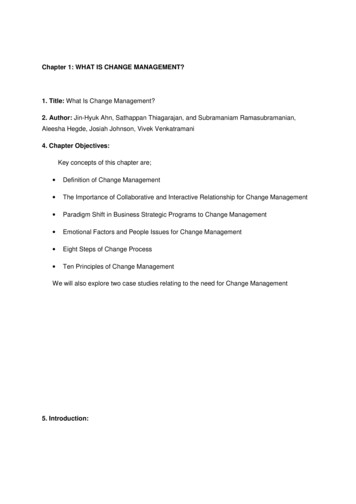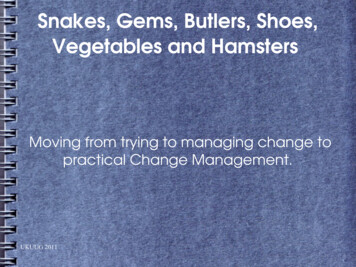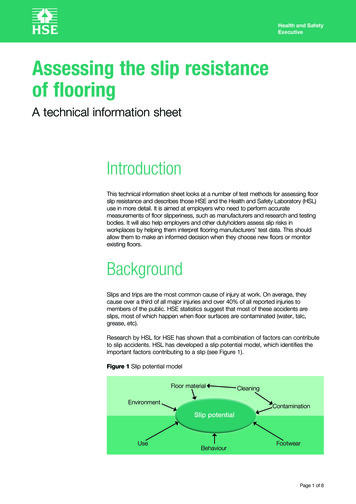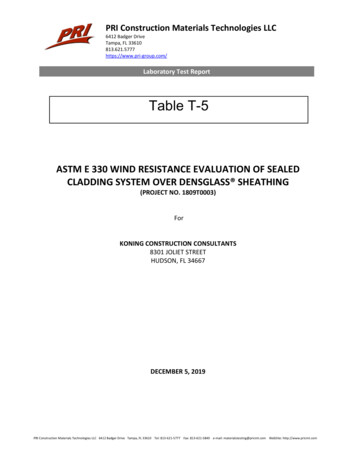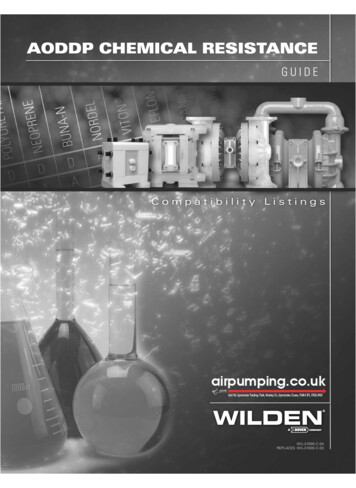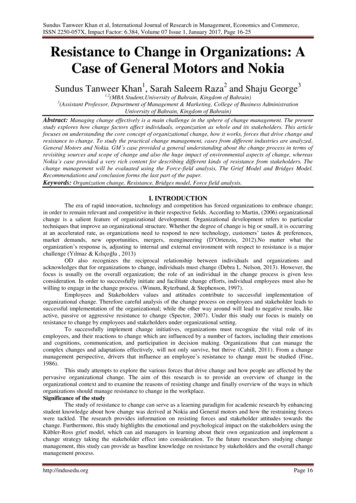
Transcription
Sundus Tanweer Khan et al, International Journal of Research in Management, Economics and Commerce,ISSN 2250-057X, Impact Factor: 6.384, Volume 07 Issue 1, January 2017, Page 16-25Resistance to Change in Organizations: ACase of General Motors and NokiaSundus Tanweer Khan1, Sarah Saleem Raza2 and Shaju George31,2(MBA Student,University of Bahrain, Kingdom of Bahrain)(Assistant Professor, Department of Management & Marketing, College of Business AdministrationUniversity of Bahrain, Kingdom of Bahrain)3Abstract: Managing change effectively is a main challenge in the sphere of change management. The presentstudy explores how change factors affect individuals, organization as whole and its stakeholders. This articlefocuses on understanding the core concept of organizational change, how it works, forces that drive change andresistance to change. To study the practical change management, cases from different industries are analyzed,General Motors and Nokia. GM’s case provided a general understanding about the change process in terms ofrevisiting sources and scope of change and also the huge impact of environmental aspects of change, whereasNokia’s case provided a very rich content for describing different kinds of resistance from stakeholders. Thechange management will be evaluated using the Force-field analysis, The Grief Model and Bridges Model.Recommendations and conclusion forms the last part of the paper.Keywords: Organization change, Resistance, Bridges model, Force field analysis.I. INTRODUCTIONThe era of rapid innovation, technology and competition has forced organizations to embrace change;in order to remain relevant and competitive in their respective fields. According to Martin, (2006) organizationalchange is a salient feature of organizational development. Organizational development refers to particulartechniques that improve an organizational structure. Whether the degree of change is big or small, it is occurringat an accelerated rate, as organizations need to respond to new technology, customers’ tastes & preferences,market demands, new opportunities, mergers, reengineering (D’Ortenzio, 2012).No matter what theorganization’s response is, adjusting to internal and external environment with respect to resistance is a majorchallenge (Yılmaz & Kılıçoğlu , 2013)OD also recognizes the reciprocal relationship between individuals and organizations andacknowledges that for organizations to change, individuals must change (Debra L. Nelson, 2013). However, thefocus is usually on the overall organization; the role of an individual in the change process is given lessconsideration. In order to successfully initiate and facilitate change efforts, individual employees must also bewilling to engage in the change process. (Winum, Ryterband, & Stephenson, 1997).Employees and Stakeholders values and attitudes contribute to successful implementation oforganizational change. Therefore careful analysis of the change process on employees and stakeholder leads tosuccessful implementation of the organizational; while the other way around will lead to negative results, likeactive, passive or aggressive resistance to change (Spector, 2007). Under this study our focus is mainly onresistance to change by employees and stakeholders under organizational setting.To successfully implement change initiatives, organizations must recognize the vital role of itsemployees, and their reactions to change which are influenced by a number of factors, including their emotionsand cognitions, communication, and participation in decision making. Organizations that can manage thecomplex changes and adaptations effectively, will not only survive, but thrive (Cahill, 2011). From a changemanagement perspective, drivers that influence an employee’s resistance to change must be studied (Fine,1986).This study attempts to explore the various forces that drive change and how people are affected by thepervasive organizational change. The aim of this research is to provide an overview of change in theorganizational context and to examine the reasons of resisting change and finally overview of the ways in whichorganizations should manage resistance to change in the workplace.Significance of the studyThe study of resistance to change can serve as a learning paradigm for academic research by enhancingstudent knowledge about how change was derived at Nokia and General motors and how the restraining forceswere tackled. The research provides information on resisting forces and stakeholder attitudes towards thechange. Furthermore, this study highlights the emotional and psychological impact on the stakeholders using theKübler-Ross grief model, which can aid managers in learning about their own organization and implement achange strategy taking the stakeholder effect into consideration. To the future researchers studying changemanagement, this study can provide as baseline knowledge on resistance by stakeholders and the overall changemanagement process.http://indusedu.orgPage 16
Sundus Tanweer Khan et al, International Journal of Research in Management, Economics and Commerce,ISSN 2250-057X, Impact Factor: 6.384, Volume 07 Issue 1, January 2017, Page 16-25II. REVIEW OF LITERATUREAny organization practicing change faces resistance towards change (Senior & Swailes, 2010). Thissection presents a review of existing literature on organizational change, defines change management, discussessome basic reasons for change, and focuses on overall resistance to change in organizations and how toovercome it.Overview of Change in the Organizational contextOrganizational change has been defined as the process of migration from a current situation to adesired future state (Mack, Nelson, & Quick, 1998). Organizations adapt to change to adjust with internal andexternal environment (Leana & Barry, 2000) or to improve performance and compete with competitors (Keck &Tushman, 1993). When organizational change is implemented, resistance can be of two types; it can beconsidered as a phenomenon that delays the change process by obstructing its implementation or rising costs(Ansoff, 1990). Secondly, it can be any act that tries to keep the existing status quo that is tendency to donothing or to remain unchanged (Maurer, 1996). Resistance to change can also magnify certain aspects thatwere overlooked previously (Waddell & Sohal, 1998).Todnem, (2005) describes organization change as a process of continually renewing an organization’sdirection, structure and management of people in a changing environment.According to Simmering (Simmering, Reactive vs. Proactive Change, n.d.), Change in any part or atany level of the organization may have an effect on the entire organization and it could be proactive or reactive.Proactive change includes effectively endeavoring to make modifications to the work place and its practices.Organizations that adopt a proactive strategy to change are regularly attempting to maintain a strategic distancefrom a potential future risk or to exploit a potential future open door (D’Ortenzio, 2012). A reactive change hasits origins from organization’s external environment; it is an automatic reaction to a change that has taken placein the environment (Simmering, Reactive vs. Proactive Change, n.d.).Factors that drive ChangeOrganizations function inside an increasingly unstable environment and are in a state of constantchange. According to Segal-Horn & Boojihawon, (2006) various internal factors such as strengths, weaknesses,opportunities, and threats within an organization and external sources such as political, economic, social andtechnological factors trigger the organizational change. External factors take place outside the organization andcause changes within the organization such as technology, social condition, availability of resources, economy,politics and business scenario may influence organizational change; Whereas the Internal factors refer to theorganizational structure, systems, people and performance. The internal forces that influence organizationalactivities are employee behavior and attitude.Change Management DefinedChange management has been defined as “the process of continually renewing an organization’sdirection, structure, and capabilities to serve the ever-changing needs of external and internal customers”(Moran & Brightman, 2001). It also refers to the adoption of an idea, procedure, process or behavior that is newto an organization (Pierce & Delbecq, 1977).Major Objective of Change management is to maximize the collective benefits for all people involvedin the change and minimize the risk of failure to change. The major obstacle to change management isResistance to Change (K.Aswathappa, 2013).Resistance to ChangeResistance is a phenomenon that affects the change process, delaying or slowing down its beginning,obstructing or hindering its implementation, and increasing its costs (Ansoff, 1990).Oreg, (2006) definedresistance to change as a “tri-dimensional (negative) attitude towards change, which includes affective andbehavioral components” and such kind of resistance needs to be overcome or eliminated (Mabin, Forgeson, &Green, 2001).Resistance to change is a repetitive theme in the change management literature (Cummings & Worley,2015). Change process is delayed due to resistance (Ansoff, 1990); it is perceived as “collateral damage” ofchange endeavors. Resistance can have many different appearances like intentional delays in work, resigning,going on strikes, sabotaging organization’s property and whistle blowing (Carr & Brower, 2000).The reasons why employees usually resist change are having fear of the unknown, misunderstanding of the needfor change and its repercussions, and a low tolerance towards change (Kotter & Schlesinger, 2008). Accordingto Dent & Goldberg (1999) people don’t actually resist change they instead resist loss of status, pay, or comfort.Responses to ChangeAccording to the Organizational scholars the success of change initiatives can be determined by theindividual's response to the change. An organization's functioning is composed of the functioning of all itsmembers. Thus, it can only change when members' behavior changes. It is not possible for an organization tochange in meaningful ways unless employees believe differently, think differently and behave differently(Woodman & Dewett, 2004).http://indusedu.orgPage 17
Sundus Tanweer Khan et al, International Journal of Research in Management, Economics and Commerce,ISSN 2250-057X, Impact Factor: 6.384, Volume 07 Issue 1, January 2017, Page 16-25Gardner, Pierce, & Dunham, (1989) suggested that there are three types of individual’s responsetoward change; affective, cognitive and behavioral. Affective response refers to the feeling of being linked tosatisfaction or anxiety about change. Cognitive responses are opinions relating to usefulness and necessity andabout knowledge required to handle change. Instrumental responses refer to actions already taken or which willbe taken to handle the change.Overcoming Resistance to ChangeJust because employees may resist change doesn't mean managers can't help them cope with it.Employee involvement and empowerment are usually mentioned in organizational change literature to helpreduce employee’s resistance to change. Kotter and Schlesinger (2008) presented a better perspective toencourage and support employees cope with change, stating that the situation and the content of the changeitself varies largely between organizations and it should determine the appropriate response. They outlined anumber of approaches from education to coercion, describing who and when to use them to reduce resistance,and details the advantages and drawbacks of each.Different personality types of individuals should also be taken into consideration for addressing change(Myers, McCaulley, Quenk, & Hammer, 1998). In this study the change management and resistance to changehas been analyzed and evaluated by using the Force-field analysis, The Grief Model and Bridges Model.Objectives of the study1. To identify the driving forces of change for Nokia & GM.2. To examine the practical implementation of change process in Nokia & GM.3. To analyze employees’ response, resistance to change and difficulties faced by Nokia & GM4. To assess how Nokia & GM managed to reduce resistance to change and evaluate their change strategywith change models.III. METHODOLOGYSelecting the methodology to study a social reality is shaped by the nature of problem that is underquestion. Qualitative method rather than the quantitative method is more convenient to choose, considering thevarious elements inherited in the concept of resistance and its complexity. Some specific cases which present anappropriate ground for the study were chosen. The material gathered through journals, websites, and documentshave been substantially rich in providing with the necessary information.Data CollectionQualitative ResearchThe research design employed for this study is qualitative and aimed at studying behavioral act such asresistance to change during the time when an organization undergoes the change process. Applying this researchdesign, helped to acquire an in-depth practical insight of the subject matter, which may be hard to acquirethrough survey data and quantitative techniques. The study uses real case studies from organizations that haveexperienced the process of organizational change. Under qualitative design, this study specifically uses casestudies of selected organizations (i.e. NOKIA, General Motors) to examine practical implementation of changeprocesses.Selection of case studiesOne of the case studies that were selected explains the change process that took place in GeneralMotors. This case provided a general understanding about the change process in terms of revisiting sources andscope of change and also the huge impact of environmental aspects of change.The second case study is based on Nokia which provides a very r
organizational structure, systems, people and performance. The internal forces that influence organizational activities are employee behavior and attitude. Change Management Defined Change management has been defined as “the process of continually renewing an organization’s direction, structure, and capabilities to serve the ever-changing needs of external and internal customers”

